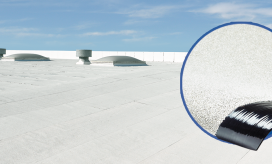Facing labor shortages and the need to maximize profit, commercial roofers have had to find new ways to move efficiently from one project to the next. Traditional low-slope roofing methods utilizing mopped asphalt or torch welding come with application constraints and safety considerations that can increase time spent on a jobsite and create challenges for workers, resulting in increased contractor insurance costs. Traditional installation methods can also generate fumes that cause discomfort for clients.
Evolving with market demands, self-adhered SBS (styrene butadiene styrene) modified bitumen (‘mod bit’) roofing systems offer roofers a safe, clean and quick alternative to those installed by traditional methods. When installed properly, self-adhered systems can deliver the protection of those applied with hot asphalt or cold (solvent-based) adhesive for a fraction of the labor or time, all without the mess, fumes, hassle or additional safety risks. Available with a variety of base sheet options, cool roof surfacing, impact resistance, uplift resistance and fire retardance, self-adhered products are versatile enough to accommodate nearly any residential or commercial low-slope roofing project.
Considerations before installation
Every professional roofer is familiar with the general tools needed to complete a low-slope roof installation. Self-adhered roofing does require a few specialized, yet easy-to-acquire tools:
- A weighted roller for pressing the membrane into place
- Suitable trowel for applying adhesive to flashing details (if not using a hot air welder)
- Caulk gun for applying any adhesives
- Seam probing tool to check for small voids
Plus, if priming:
- Long-handled (standing) roller with 1/8"-1/4" nap for applying primer (1/8" nap for smooth surfaces, 1/4" nap for more porous surfaces)
In cold weather:
- Replace the trowel with a hot air welder (if manufacturers’ application instructions call for it)
As a rule of thumb, for residential applications, self-adhered roofing should only be applied on plywood decks that are at least 1/2” thick and OSB (oriented strand board) decks at least 7/16” thick, each with a minimum slope of 1/4”. It is recommended that an anchor sheet be mechanically attached to the wood deck prior to self-adhering a ply or cap layer.
For commercial roofing applications, it’s important to consider the client’s location and needs, as well as local building code requirements. Increasingly, new building codes and regulations are calling for the use of self-adhering products due to their environmentally-friendly installation. Self-adhered roofing can be installed quickly with little disruption to clients who may be living or working in a building, making it a great choice for roofing projects involving offices, restaurants, schools, hospitals, hotels, care facilities and multi-family structures, where client comfort is paramount.
Self-adhered versus TPO, single-ply roofing
Self-adhered modified bitumen roof systems come with several advantages over TPO, single-ply roofing systems. Thermoplastic polyolefin (TPO) single-ply roofing membranes are typically offered with 20-year warranties, but manufacturers are now on their sixth formula iteration and have yet to effectively resolve cracking, erosion and other performance concerns that can occur well before the 20-year mark. The formula for SBS-modified asphalt material utilized in self-adhered roofing has remained unchanged for over 40 years. Additionally, self-adhered roof systems are typically installed in two or three layers, which reduce leak risk as compared to a single-layer installation. TPO single-ply roof systems range between 40-80 mils in thickness, while most self-adhered roof systems range from 180-380 mils, making self-adhered systems less susceptible to puncture from foot traffic. Even with multiple-layer installation, the labor associated with self-adhered mod bit roof systems is lower than TPO roof coverings. While material costs are greater for multi-layer systems, installed costs for self-adhered mod bit and TPO roof coverings are typically comparable, and labor costs for self-adhered systems are significantly less.
Not all self-adhered products are made equal
While many modified bitumen manufacturers offer a self-adhered product line, product performance varies by brand. When selecting a self-adhering roofing product, contractors should ask the following:
- How well does the product adhere to the roofing substrate?
- How well does the cap sheet adhere to the base or interply layers?
- Can the adhesive withstand expansion and contraction stresses without delaminating, specifically at sidelaps, endlaps and details?
- How well does the product handle in cold weather?
- Does the product scuff or compress from foot traffic in hot weather?
- How well are granules retained on the cap sheet?
- Does the release film remove quickly and easily during installation?
- Is the product manufactured with consistent quality, per the considerations above?
Like any product, self-adhered mod bit products have their limitations. Typically, it becomes difficult for these products to achieve full bond strength as temperatures drop below 40°F. For this reason, some roofers who prefer self-adhered mod bit systems resort to other systems during the fall and winter seasons.
Through research and development, however, newer self-adhered systems can achieve full bond strength using techniques such as a hot air welder for flashing details, allowing roofers to enjoy time and labor-savings in any season. And while another advantage of self-adhered roofing is a reduced training requirement, training is still important. An untrained crew can waste both time and material trying to properly apply self-adhered roll goods, especially in elevated temperatures.
With self-adhered roofing, it’s easy to provide clients with a reliable, watertight, low-slope roof, all while minimizing disruption, keeping employees safe and minimizing time spent at the jobsite.
To learn more about self-adhered low-slope roofing, visit www.certainteed.com/commercial-roofing/.


